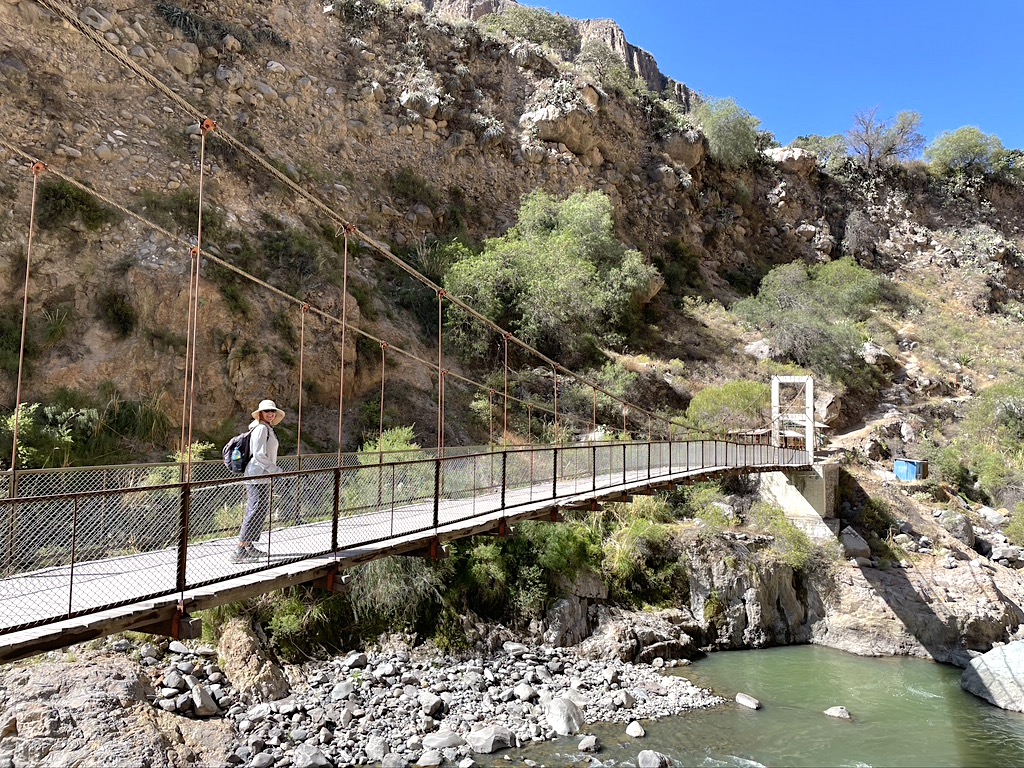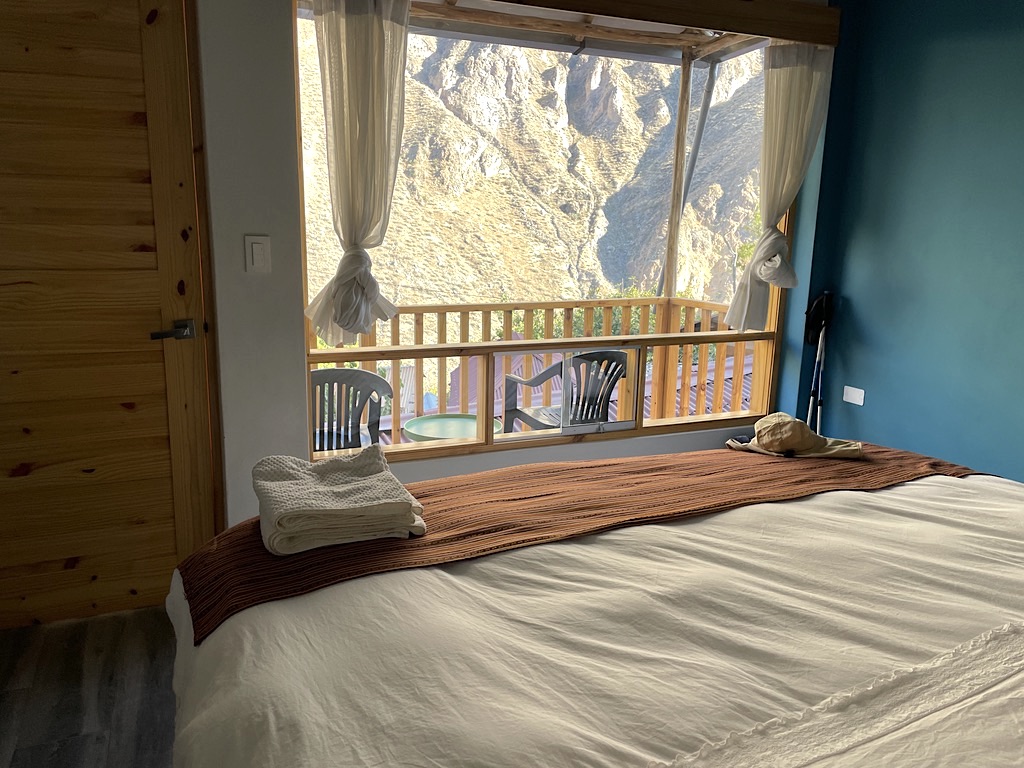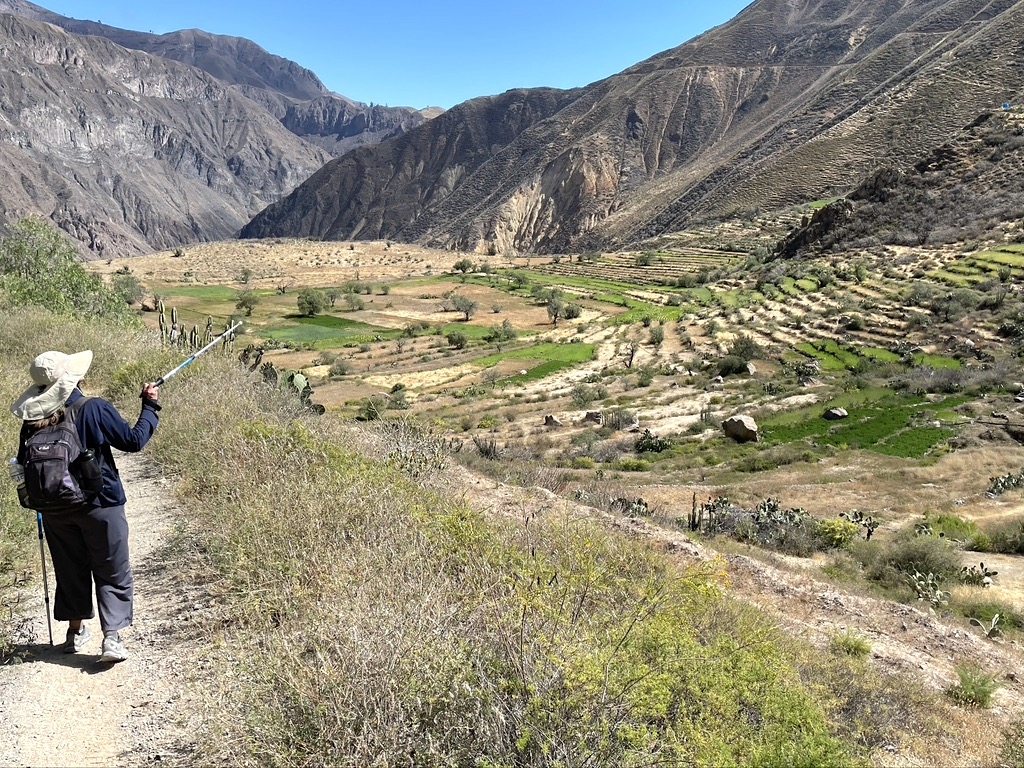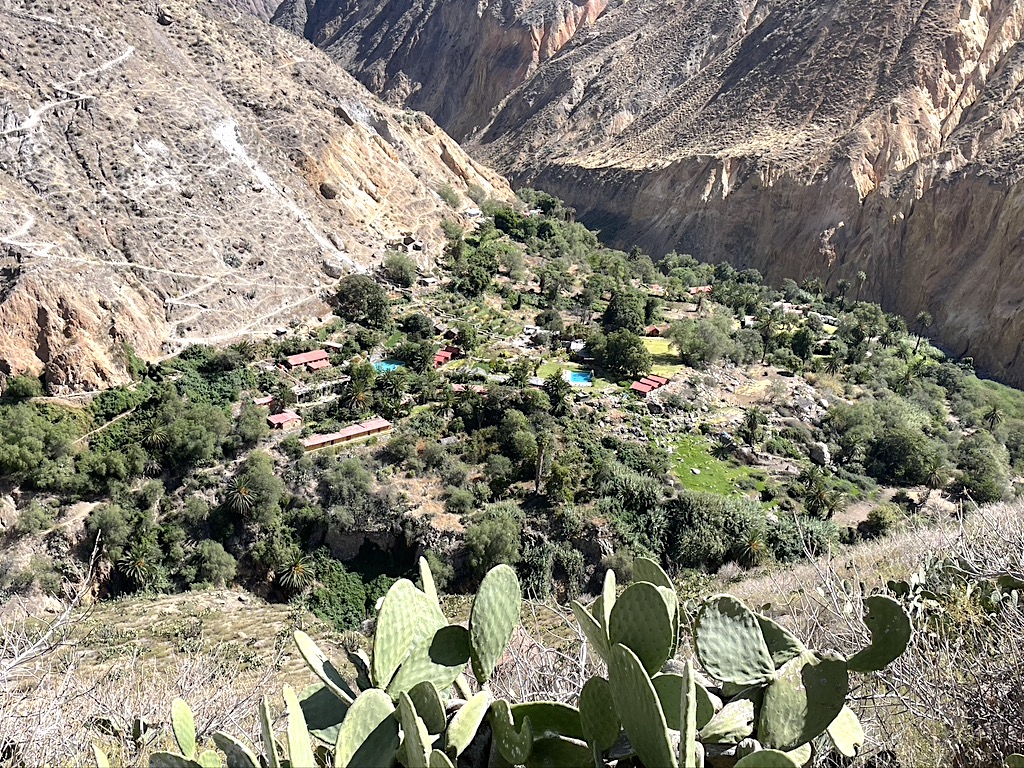Re-energized after a week in the “white City” of Arequipa, we climbed up onto the Andean Plateau in search of new adventures. Our first discovery was the imposing Colca Canyon. To experience the canyon and visit the indigenous people inhabiting the floor of the chasm, we set off on a three-day hiking trek.

Upon our arrival at the rim of Colca Canyon, we were greeted by a flock of Andean Condors gliding effortlessly on rising currents of thermal air. Combining its maximum weight of 33 pounds (15 kg) and wingspan of 11 feet (3.3 m), it is the largest flying bird in the world.

At the trailhead, we met our expert guide, Walter. Over the course of the next three days, Walter set a reasonable pace and shared his deep canyon full of knowledge. Besides ensuring our safety and comfort, Walter patiently described the geology, biology, and cultural anthropology of the Colca Canyon.

On the first day, Walter led us down to the bottom of the canyon. Colca Canyon is considered the second deepest canyon in the world. At its deepest, it measures almost 11,000 feet (3,300 m). Thankfully, our descent to the base of the canyon was only a manageable 3,500 feet (1,100 m) in depth.

Winding down the steep trail, alongside walls of volcanic andesite and columnar basalt, we ultimately reached the Colca River, crossed a suspension bridge, and bought a lukewarm Coke from a local woman. When I asked her for a “Colca” Cola, she laughed like I was the first person to ever crack that joke.

With our legs aching from the long downhill descent, we checked into the Colibrí Lodge in the rural canyon village of San Juan de Chuccho. Expecting primitive accommodations, we were astounded by its modern construction, clean luxurious rooms, and delicious gourmet meals.

At the lodge, we met Benito, a local guinea pig farmer, who led us down to the river to fish for rainbow trout. Using only a hook, worm, and spool of fishing line, we unfortunately failed to snare the big one. As consolation, Benito netted six small troutlets, and grilled them for us on a riverside fire as a light snack.

On the second day of our trek, we meandered upstream along the Colca River through lush farmer’s fields and small remote villages. Along the way, we met good-natured canyon dwellers and observed rural life in this unique setting on the canyon floor.

Rising from the fertile base of the canyon, we also marveled at fruitful terraced fields and orchards. Here, water channels, expertly engineered from as far back as pre-Inca times, irrigated the stair-stepped plots with clear ice-melt from the nearby Andes mountains.

For our second night in the canyon, we experienced the primitive accommodations we had expected in the oasis village of Sangalle. After a restless night’s sleep, we set out at 4:00 am to hike out of the canyon. Three hours later, just as the sun was rising over the canyon rim, we concluded our trek, exhausted but triumphant after our three-day adventure in the Colca Canyon.



A fabulous region. By the way, does Peru get many tourists?
LikeLiked by 1 person
Hey Neil. Perú is a fabulous and popular place to visit. As we have moved around the country, we have been mostly following the tourist trail. Buses, tours, hotels, and restaurants all seem pretty busy. The locals say that the tourist numbers are still not up to pre-pandemic levels, but we see many most everywhere we have been. Thanks for the question. See ya!
LikeLiked by 1 person
Fantastic! I bet your “condor moment” was something to savour, what an experience. In a way it’s good that your accommodation was variable in quality and type – makes the whole thing even more memorable, or at least adds to the memories. Great write-up.
LikeLiked by 1 person
Thanks Phil & Michaela! Given your fondness for local people and cultures and your love of a good hike, Colca Canyon would be right up your alley. We were lucky to see about a dozen condors riding the thermals. It is the dry season in Perú, and the conditions were perfect for soaring. You are right about the varying accommodations. Perhaps reversing the order would have been preferable (rough it the first night and enjoy some luxury on the second).
LikeLiked by 1 person
Absolutely wonderful pics here, Joe. You really outdid yourself here. Specifically that pic of Esther and Walter in the foreground of the canyon shot is amazing. Ditto for the elevated cactus shot. The lodge room looks wonderful, and I assume you really appreciated having it after walking that terrain. – Marty
LikeLiked by 1 person
Thanks, Marty! This was a very fun post to put together. We were lucky to have a small group (five including Walter). It gave me the chance to take some pictures on the way down with just Esther and Walter up ahead (our hiking partners liked to stop a lot and take pictures themselves). The room blew us away. We had paid about $7 to upgrade to a private room and bath, and got a big bang for our buck. The big comfortable bed and quiet on the canyon floor was just the recipe for our tired muscles and a great night sleep.
LikeLiked by 1 person
Hi Joe. I’ve just read your previous Peru updates and now this fabulous one. What a magnificent adventure you are on! I admit that I knew/know little about Peru beyond Machu Picchu but you’ve definitely whet my appetite to learn more. If I am ever fortunate enough to go myself, I’ll absolutely look to you for tips.
LikeLiked by 1 person
Hi Janis. We have met a lot of fellow travelers, mostly from Europe and the USA. Perú is an excellent travel destination. It has a rich indigenous culture, interesting history, and wide range of geographical settings. We started in Lima at sea level and have now been living two miles high for the last week. Machu Picchu is certainly the top tourist attraction in Perú. If all goes well, we will arrive there on the winter solstice (June 21). Hope you are doing well, and can make it down here someday.
LikeLiked by 1 person
Looks like an interesting place for a hike. For me, I think the highlight would be the big condors. Just the pure size soaring through the air, and the notion that they’re really dinosaurs…
LikeLiked by 1 person
The condors were a big highlight for me too, Dave. They were flying right over us. I wish you were there with your camera to capture them in flight. Even I got some decent shots with my iPhone. These enormous birds are scavengers not raptors. Because local peoples incorrectly thought that the condors were killing their livestock, instead of feeding on already dead animals, the ranchers killed them and the species became extremely endangered. Thankfully, they have begun to recover and we got to see a dozen of them soaring majestically overhead.
LikeLike
That looks amazing! I would love to see condors and the views are to die for. As for the guinea pig farmer, what do they do with them? Are they food in Peru? I also loved how the irrigation methods stem back from the times of the Incas….
LikeLiked by 1 person
Colca Canyon is an amazing place, Ann. We were lucky to see the condors and to have a guinea pig farmer take us fishing. Guinea pigs (called cuy) are raised for food in Perú. Many Peruvian families have guinea pig for their Sunday dinner or for special occasions, like turkey at Thanksgiving. Coincidentally, I ate my first (and last) one for lunch today. I had to try it, and discovered that I am not a fan. The meat was pretty tasty, but pulling apart the roasted little guy was distressing. I have also been seeing a lot of Inca sites, and their masonry and irrigation systems are true engineering marvels. I am planning to show some good examples in a future post.
LikeLiked by 1 person